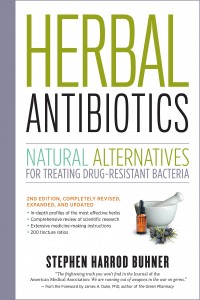
The book is very adamant that not only can plant medicines help to combat infections, but that using them on a daily basis is a highly effective method of building the body’s natural defenses against an infection before the illness strikes.
The herbs are broken down into several categories, as such:
Systemic Antibacterials: these herbs are taken up readily within the system and spread throughout a person’s body by way of the bloodstream to all of the cells and organs and fighting system-wide illnesses and organisms. MRSA is an example of such a disease.
Localized Antibacterials: are herbs that are effectively confined and applied to specific regions of the body, such as the stomach or liver, or on external wounds. An example here would be an E. coli infection that affects the digestive system.
Facilitative/Synergistic Herbs: these are plant medicines that are taken in conjunction with other herbs or pharmaceuticals that have a potentiating (increasing in effectiveness) effect. An example in this category would be Berberine, a powerful antibacterial that is increased in effectiveness when taken in conjunction with Goldenseal and used to combat MRSA.
The cool thing about this book is that it enables you to sort what you need by disease and disease-type (gram positive or gram negative bacteria, for example), by herb, and by presenting symptoms that will enable you to categorize and positively identify an infection. Each different herbal remedy and compound is explained, along with dosages and methods of preparation, step by step, these methods themselves being exceptional in detail and simplistic in their presentation. Even more: the book tells you how to grow, harvest, and collect (in the wild) the different herbs listed.
The herbs are described in terms of their chemical and scientifically-revealed properties, such as wound healing, pain relief, and effects on the human immune system, for examples. The plant chemistry and methods of employment are described in great detail. Preparations and dosages are meticulously listed, along with all of the medical and scientific research and tabulated results from studies (with references) that substantiate their uses throughout the world. Complete descriptions of tinctures, oils, capsules, salves, poultices, and many other vehicles for use of the medicines are provided, along with step-by-step instruction on how to prepare them.
The only thing lacking in the book, in this author’s opinion, is a good section with color photographs of the actual plants themselves. This, however, is the norm for most herbal and naturopathic works, and as I have strongly advised in the past, the Peterson’s guides for wild medicinal herbs (the guides are done by region, such as Eastern United States), and the PDR for Herbal Medicines will be useful for identification as such. This book by Buhner is a hands-on, no frills guide that is packed with information you can readily use, as well as the techniques with which to employ that information.
“The thing of it is,” to quote Mr. Henry Bemis of “The Twilight Zone,” is that this book will really serve you well in a SHTF, grid-down or natural disaster scenario. Diseases such as typhus, cholera, dysentery, and others will be prevalent in such situations. The bacterial infections will be seen in your locality; this book will help you to identify the illness and to take that definitive action to arrest the process. The book is 467 pages and you can find it on Amazon.com for about $25…a very worthwhile investment that will serve you well for your daily routine or for when the SHTF.
So check out “Herbal Antibiotics” for your preparedness library. Success is not only where you find it: it’s also how you make it. This fine work is another good tool to enable you to prepare for the next flu season, and also for when times are much harder. It is a prime example of how you can use the resources growing right in the woods near your home to craft plant medicines to serve you and your family in time of need. Stay well, and keep fighting that good fight….and fight smart! JJ out!
